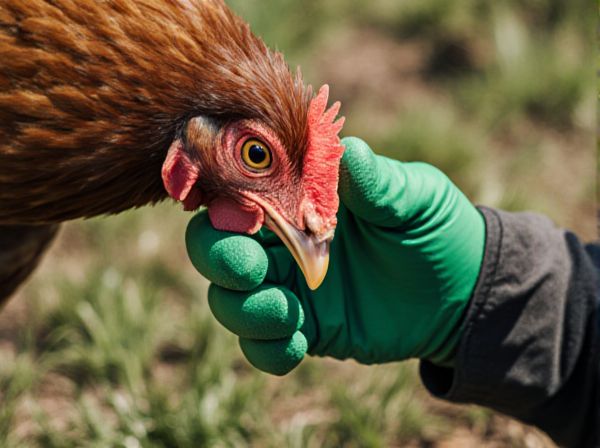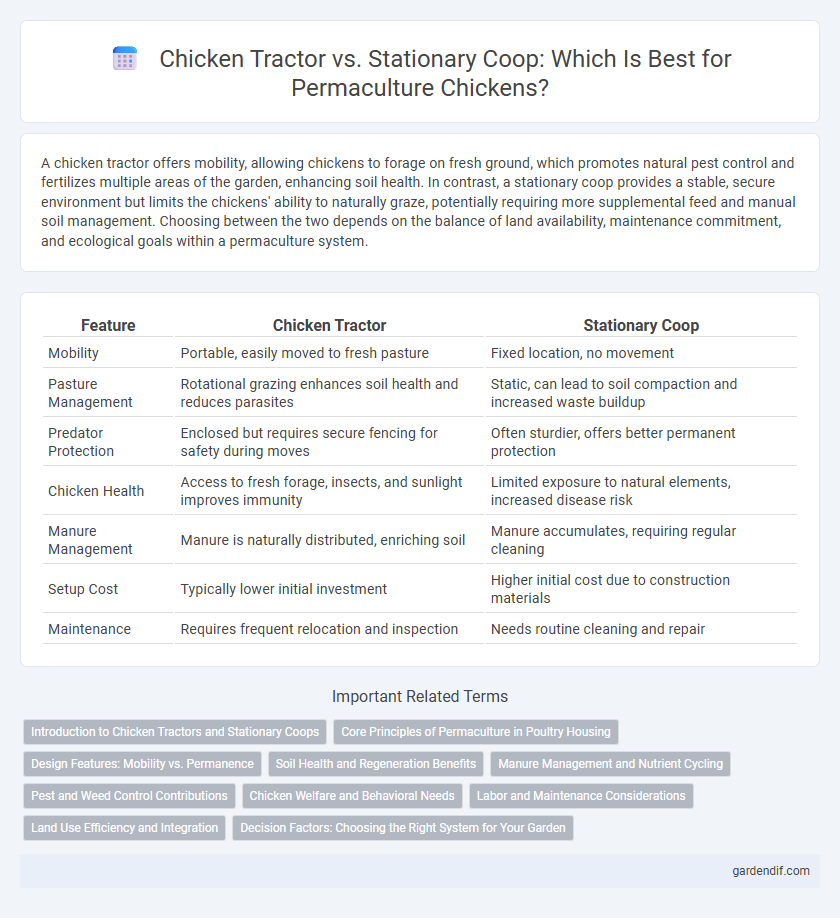
Chicken tractor vs Stationary coop Illustration
A chicken tractor offers mobility, allowing chickens to forage on fresh ground, which promotes natural pest control and fertilizes multiple areas of the garden, enhancing soil health. In contrast, a stationary coop provides a stable, secure environment but limits the chickens' ability to naturally graze, potentially requiring more supplemental feed and manual soil management. Choosing between the two depends on the balance of land availability, maintenance commitment, and ecological goals within a permaculture system.
Table of Comparison
| Feature | Chicken Tractor | Stationary Coop |
|---|---|---|
| Mobility | Portable, easily moved to fresh pasture | Fixed location, no movement |
| Pasture Management | Rotational grazing enhances soil health and reduces parasites | Static, can lead to soil compaction and increased waste buildup |
| Predator Protection | Enclosed but requires secure fencing for safety during moves | Often sturdier, offers better permanent protection |
| Chicken Health | Access to fresh forage, insects, and sunlight improves immunity | Limited exposure to natural elements, increased disease risk |
| Manure Management | Manure is naturally distributed, enriching soil | Manure accumulates, requiring regular cleaning |
| Setup Cost | Typically lower initial investment | Higher initial cost due to construction materials |
| Maintenance | Requires frequent relocation and inspection | Needs routine cleaning and repair |
Introduction to Chicken Tractors and Stationary Coops
Chicken tractors are movable poultry housing units designed to allow chickens to forage on fresh ground while providing shelter and protection from predators. Stationary coops are fixed structures that offer permanent housing with more controlled environments but less access to diverse forage. Both systems support sustainable poultry management but differ in mobility, foraging opportunities, and maintenance requirements.
Core Principles of Permaculture in Poultry Housing
Chicken tractors align with permaculture principles by promoting soil health and natural pest control through rotational grazing, enhancing nutrient cycling and biodiversity. Stationary coops may require more external inputs and can lead to soil degradation if not managed properly, contrasting with permaculture's emphasis on low-impact, regenerative systems. Prioritizing mobility and ecological integration in poultry housing supports sustainable, self-sufficient farm ecosystems.
Design Features: Mobility vs. Permanence
Chicken tractors are designed for mobility with lightweight frames, open bottoms, and wheels, allowing them to be moved regularly to fresh pasture, which enhances soil fertility and bird health. Stationary coops emphasize permanence with solid foundations, fixed structures, and integrated nesting boxes, providing stable shelter and protection from predators year-round. The choice between mobility and permanence impacts waste management, predator control, and the sustainability of the poultry system in permaculture.
Soil Health and Regeneration Benefits
Chicken tractors enhance soil health by allowing chickens to naturally till and fertilize rotating sections of land, promoting nutrient cycling and increasing microbial activity. Stationary coops provide consistent manure deposits in one area, which can lead to soil compaction and nutrient overload, potentially harming soil structure and biodiversity. Utilizing chicken tractors supports regenerative permaculture practices by improving soil aeration, reducing pest populations, and fostering a balanced ecosystem.
Manure Management and Nutrient Cycling
Chicken tractors enhance manure management by allowing chickens to deposit waste directly onto rotating garden beds, promoting nutrient cycling through natural fertilization and soil enrichment. Stationary coops require manual manure collection and composting, which can lead to nutrient runoff if not managed carefully. Integrating chicken tractors into permaculture systems optimizes nutrient distribution, reduces labor, and supports soil health more effectively than stationary coops.
Pest and Weed Control Contributions
Chicken tractors enhance pest and weed control by allowing chickens to forage and scratch directly on different sections of land, naturally reducing insect populations and suppressing weed growth without chemicals. Stationary coops limit this behavior to confined areas, which can lead to accumulated waste and uneven pest management, sometimes requiring supplemental interventions. Rotating chicken tractors systematically mobilizes poultry benefits, improving soil health and integrated pest management in permaculture systems.
Chicken Welfare and Behavioral Needs
Chicken tractors enhance chicken welfare by allowing natural foraging, dust bathing, and exercise, promoting healthier behaviors compared to stationary coops. Stationary coops often limit space and environmental enrichment, leading to stress and increased risk of disease. Rotational use of chicken tractors supports better parasite control and soil fertilization, aligning with chickens' instinctual needs for movement and varied habitat.
Labor and Maintenance Considerations
Chicken tractors require frequent movement and daily monitoring, increasing labor time but promoting healthier pasture and reduced parasite buildup. Stationary coops demand less daily labor but need regular deep cleaning and ventilation management to prevent ammonia buildup and disease. Maintenance in chicken tractors centers on mobility components and fencing integrity, while stationary coops focus on structural upkeep and waste removal systems.
Land Use Efficiency and Integration
A chicken tractor maximizes land use efficiency by allowing chickens to graze small plots sequentially, enhancing soil fertility through natural manure distribution and pest control. In contrast, a stationary coop confines chickens to a fixed area, often leading to overused soil and requiring manual waste management. Integrating a chicken tractor with crop zones promotes symbiotic relationships, optimizing both poultry productivity and garden health within a permaculture system.
Decision Factors: Choosing the Right System for Your Garden
Choosing between a chicken tractor and a stationary coop depends on garden size, soil health goals, and chicken mobility needs. Chicken tractors promote natural fertilization and pest control through daily relocation, enhancing soil aeration and nutrient cycling. Stationary coops require designated space but offer easier management and protection from predators in smaller or enclosed gardens.
Chicken tractor vs Stationary coop Infographic

 gardendif.com
gardendif.com